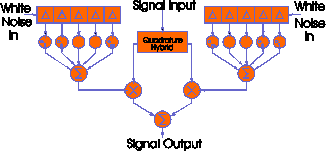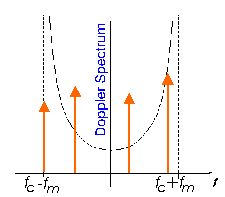
Rayleigh Fading Simulator
Narrowband Rayleigh fading is modelled often as a random process that
multiplies the radio signal
by a complex-valued Gaussian random function.
The spectrum of this random function is determined by the Doppler spread of the channel.
Thus one can generate
two appropriately filtered Gaussian noise signals and use these to modulate the signal and a 90 degree phase shifted version of the signal.

Figure: Block diagram of a narrowband Rayleigh fading simulator
(in baseband)
Jakes' Simulator
It is common practice to generate the two filtered noise components by adding a set
of six or more sinusoidal signals. Their frequencies are chosen as to
approximate the typical U-shaped Doppler spectrum.
Figure: Crude approximation (orange) of the theoretical Doppler spectrum (Black)
used in animation taking only 4 components. (N=3)
N Frequency components are taken at
2 p i
fi = fm cos -------- with i = 1, 2, .., N
2(2N+1)
This specific set of frequencies is chosen to
approximate the U-shaped Doppler spectrum.
All amplitudes are taken equal to unity.
One component at the maximum Doppler shift is also added, but at
amplitude of 1/sqrt(2), i.e., at about 0.707 .
Jakes suggests to use 8 sinusoidal signals.
Frequency Domain Simulator
Many channel simulation models follow the narrowband model. Wideband channels
are often simulated by extending the model assuming multiple time-delayed
resolvable paths. This allows the simulation of the channel impulse response,
including its stochastic behavior. To determine the performance of an multicarrier,
OFDM or MC-CDMA system, another approach can be to model a set of fading
subchannels. Considering a single subcarrier, the channel may be modelled
as a narrowband fading channel, for instance with Rician or Rayleigh amplitude
distributions. The collection of multiple subcarriers can be modelled as
a set of mutually dependent fading channels. See: analysis and model behind this approach.








